|
|
| THE
ART OF LES COSGROVE
by
Robert J. Lewis
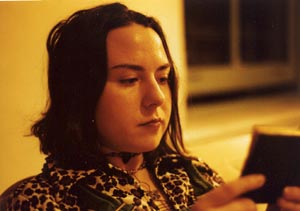 Pop
Art emerged in the 1950s in England and the US. It was initially
a reaction against Abstract Expressionism. Its luminaries were
Jasper Johns, Rauschenberg, Roy Lichtenstein and Andy Warhol.
They worked with mostly flat areas, unmixed colors and mechanical
techniques, virtually removing the artist from the creative
process. From flags, to beer cans, to cartoons, they co-opted
mostly assembly line culture and repackaged it, blurring the
distinction between high and low art. Pop
Art emerged in the 1950s in England and the US. It was initially
a reaction against Abstract Expressionism. Its luminaries were
Jasper Johns, Rauschenberg, Roy Lichtenstein and Andy Warhol.
They worked with mostly flat areas, unmixed colors and mechanical
techniques, virtually removing the artist from the creative
process. From flags, to beer cans, to cartoons, they co-opted
mostly assembly line culture and repackaged it, blurring the
distinction between high and low art.
Pop Art was the
first movement to propose that if there were a crisis in the
visual arts, it was because the art buyer could no longer distinguish
between fine art and commercial art. If a masterpiece, in part,
derives from its uniqueness, its opposite is everything mass-produced,
which is why the Mona Lisa is high art and a Cadbury candy bar
wrapper isn't, that is until Andy Warhol (1928-87) turned the
art world upside down. More interested in making a statement
about art than creating it, Warhol removed the wrap-around packaging
of a Campbell's soup can, blew it up to ten times its original,
and sold it as an artwork for thousands of dollars, proving
that Americans were the least artistically discriminating people
on the planet. What he couldn't have predicted was how quickly,
unabashedly the rest of the world would emulate the American
example.
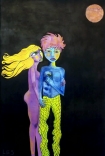 Pop
Art enjoyed two decades of high scandal and celebrity before being
succeeded by Minimalism, Post Modernism and Installation Art.
But for artists for whom Pop remains their genre of choice, it
is because in the hands of its most skilled practitioners it can
illuminate the modern urban landscape like no other art form. Pop
Art enjoyed two decades of high scandal and celebrity before being
succeeded by Minimalism, Post Modernism and Installation Art.
But for artists for whom Pop remains their genre of choice, it
is because in the hands of its most skilled practitioners it can
illuminate the modern urban landscape like no other art form.
It's a downright
dirty shame that today's critics -- and the public they inform
-- give such short shrift to Pop Art which they regard as a
product only somewhat more sophisticated than the cartoon. Viewers,
however, whose judgment has not been clouded by preconceived
notions of what art should be, will discover in the art of Les
Cosgrove, for example, paintings whose deceptive
Pop simplicity belie their serious subject matter.
As an exponent of
a Pop Art that combines new forms with a more conservative agenda,
Les Cosgrove's method, like that of phenomenology, is to strip
away everything that does not properly belong to a subject in
order to disclose its essence. If Pop's founding fathers made
fun of the art world and themselves, Cosgrove's very serious
art functions as a critique of a world whose community of orphans
and poseurs comes from mostly mall culture and suburbia.
Her world is populated with prototypes peculiar to the age of
globalization, where angst, ennui and disconnect are the unacknowledged
building blocks of disaffected youth. 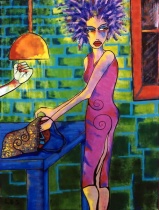  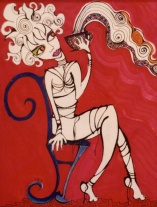 We
encounter mostly young women, who are not so much victims as
highly vulnerable to the invisible imperatives of culture that
determine how we dress, express our sexuality, and spend money
we don't have. The cumulative effect of Cosgrove's work is to
persuade us of her sympathy for a generation that has lost contact
with its vital center, for whom freedom is a scary, boundless,
dark space stripped of everything recognizable. We
encounter mostly young women, who are not so much victims as
highly vulnerable to the invisible imperatives of culture that
determine how we dress, express our sexuality, and spend money
we don't have. The cumulative effect of Cosgrove's work is to
persuade us of her sympathy for a generation that has lost contact
with its vital center, for whom freedom is a scary, boundless,
dark space stripped of everything recognizable. 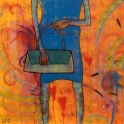
Les
Cosgrove is an artist who continues to evolve and provoke, whose
work faithfully records the pulse and heart beat of a people languishing
in the no man's land 'between heaven and Armageddon,' mistrustful
of values that don't fit, while at the same time fearful that
true value may be nothing more than a chimera, an empty promise
hardly worth waiting -- and dying for.
|
|
|